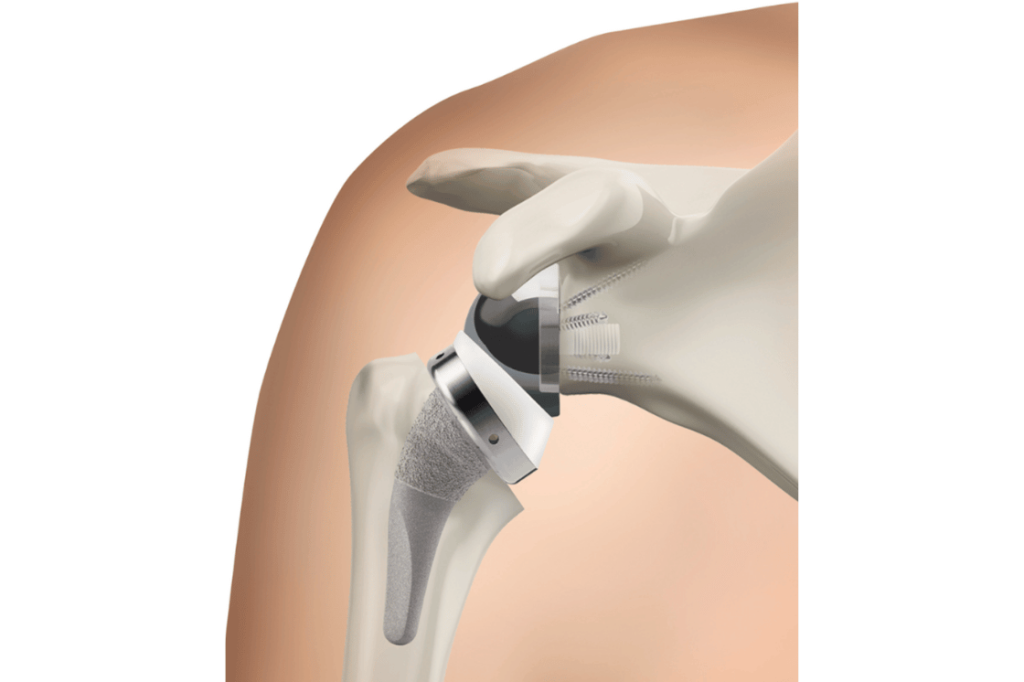Shoulder osteoarthritis (arthrosis) is a progressive and painful disease characterized by the gradual wear and tear of the cartilage tissue covering the joint surface and the narrowing of the joint space. This condition severely diminishes the patient’s daily quality of life.
Although it can be managed with methods like medication and physical therapy initially, surgical treatment may be necessary in advanced stages.In some patients, the condition is further complicated by the fact that the rotator cuff muscles, which provide movement to the shoulder joint, are severely torn or have lost their function.

In such cases, an anatomic shoulder prosthesis may be insufficient. It is at this point that reverse shoulder arthroplasty (a procedure to replace the shoulder joint) emerges as one of the most effective treatment options offered by modern surgery.In a reverse shoulder prosthesis, contrary to the shoulder’s natural anatomy, the ball-and-socket structure is swapped: the ball part is placed on the shoulder blade (scapula), and the socket is placed on the arm bone (humerus). Thanks to this special design, the deltoid muscle (the large muscle on the outside of the shoulder) is used to move the shoulder instead of the weak or non-functioning rotator cuff. This both reduces pain and largely restores arm movements.
This method is applied to elderly patients who have developed arthritis due to a rotator cuff tear (cuff tear arthropathy), have significantly reduced shoulder range of motion, and cannot actively use their shoulder. It is also an effective option for previously failed prosthesis surgeries or complex fractures.After surgery, patients significantly return to their daily lives with the right exercise program. With appropriate patient selection and careful planning, the success rate of reverse shoulder prosthesis is quite high.

Duration of Surgery: 90–120 minutes
Type of Anesthesia: General anesthesia + nerve block (an injection to numb the area)
Surgical Method: Open surgery (with a deltopectoral incision, a cut at the front of the shoulder)
First day: 4–6 (2–3 if a nerve block is applied)
First week: 3–4
After 2 weeks: 1–2
A hospital stay of 1–2 days is generally recommended
First 4–6 weeks: Protected with an arm sling
Starting from the 2nd week: Passive exercises (movements guided by a therapist or the other arm) begin
5th–6th week: Active movement (moving the arm on its own) and strengthening process
8rd month: Return to daily life activities6th month: Light sports and functional activities
First dressing change: 2nd day
Wound check: 1st week
Suture removal (if necessary): 10th day
Yes. Thanks to the deltoid muscle, lifting your arm overhead is possible for most patients. The range of motion varies from patient to patient, but a significant increase is expected.
Modern reverse shoulder prostheses can last 15–20 years or more. Trauma and excessive loading should be avoided.
It is essential that our patients perform the exercises we show them. With these movements, range of motion and muscle balance are re-established. If it is determined during periodic check-ups that the range of motion and muscle strength are lagging, assistance from physical therapy may be sought.
Pain control is quite effective thanks to nerve blocks and painkiller protocols. Post-operative pain is often less than expected.
This is a rare situation. If deemed necessary, a revision surgery (a procedure to replace the old implant) may be planned in the future.